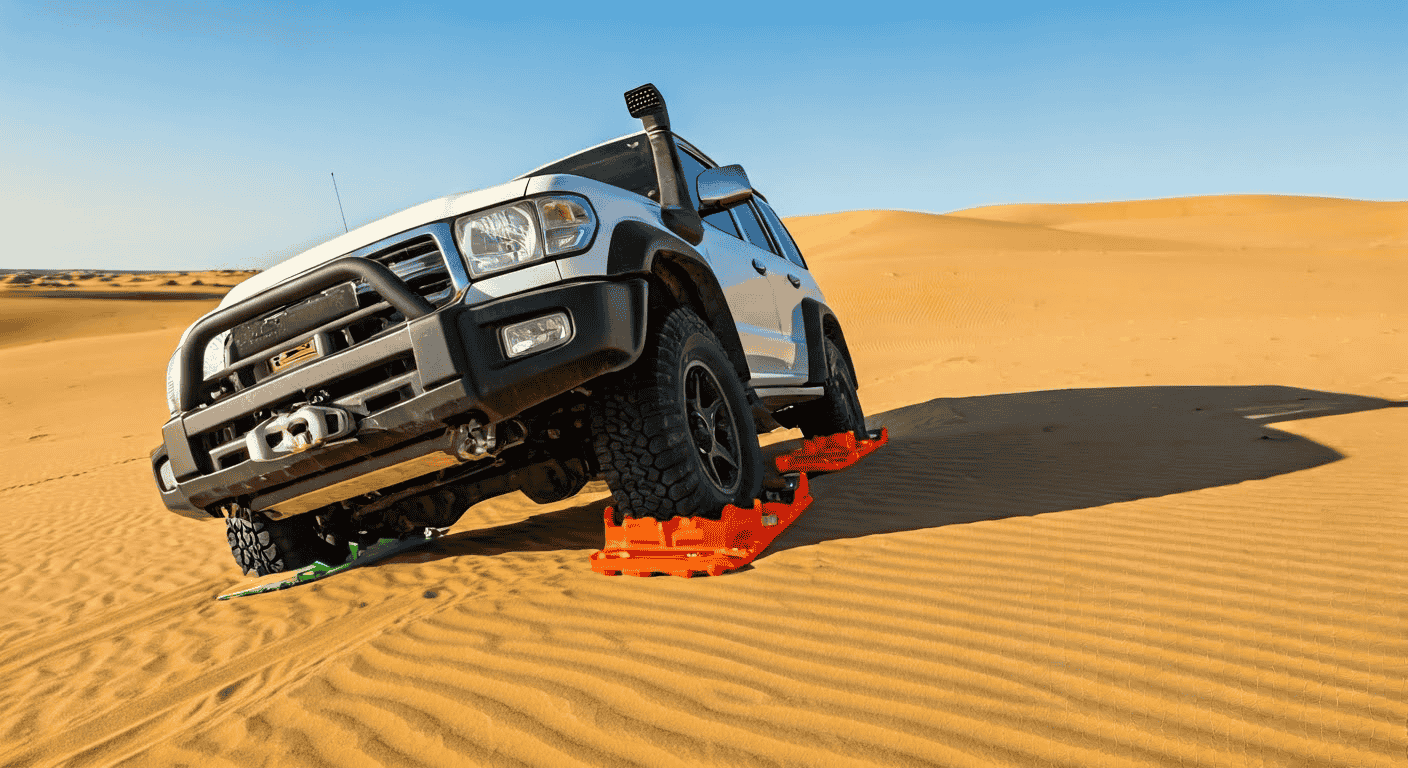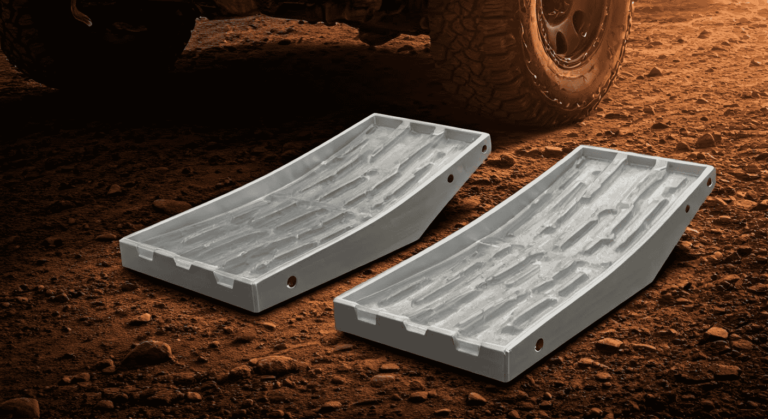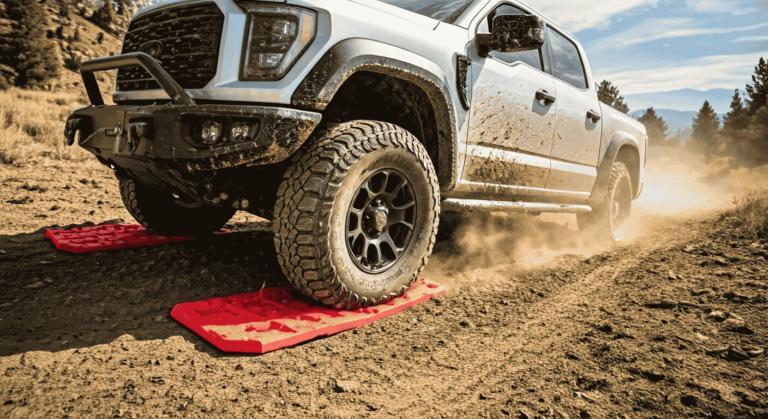Understanding Recovery Traction Boards
- What Are Recovery Traction Boards?: Recovery traction boards are robust, textured devices designed to provide additional grip for tires when a vehicle becomes stuck in sand, mud, or snow. Typically made from durable reinforced materials like nylon or composite plastics, these boards are engineered to withstand the immense pressure of a vehicle’s weight. Their strategically placed ridges and grooves interlock with tire treads, allowing for greater traction and a smoother extraction.
- Why Are They Essential for Off-Roading in Sand?: When off-roading in sandy environments, even experienced drivers can encounter soft patches where vehicles sink and lose traction. Traction boards offer a simple, effective recovery solution without the need for towing or winching. Unlike traditional recovery methods, they require minimal mechanical assistance, making them indispensable for remote adventures.
- Key Features to Look for in Traction Boards When selecting traction boards, prioritize features such as reinforced construction, UV resistance, and aggressive tread patterns. Boards with integrated handles and shovel-like ends can further assist in clearing sand. Some models include mounting brackets for convenient storage, while others feature bright colors for visibility in sandy landscapes.
Preparing for Your Off-Road Adventure
- Assessing Your Vehicle and Terrain: Before setting off, understand your vehicle’s weight, ground clearance, and drivetrain capabilities. Evaluate the terrain and check for potentially challenging sand dunes, soft patches, or coastal areas. Research the location’s weather conditions to avoid sudden sand shifts or unexpected obstacles.
- Choosing the Right Traction Boards for Sand Recovery: While many boards are multipurpose, those designed specifically for sand recovery often feature finer, more closely spaced ridges. Opt for models suited to your vehicle’s tire size and load capacity. Investing in high-quality boards with excellent abrasion resistance ensures reliable performance.
- Essential Gear to Carry Alongside Traction Boards: In addition to traction boards, carry essential recovery tools such as a folding shovel, a tire pressure gauge, and an air compressor. Recovery straps, D-ring shackles, and a portable air deflator can further assist in challenging scenarios. A first aid kit, water, and communication devices are also vital for emergencies.
Recognizing When to Use Recovery Traction Boards
- Signs Your Vehicle Is Stuck in Sand Indicators that your vehicle is stuck include spinning tires, reduced forward movement, and deep ruts forming beneath the wheels. Sand may accumulate around the tires, further impeding progress.
- Evaluating the Severity of the Situation Assess the depth of the vehicle’s sinkage and whether the tires are completely buried. If forward or reverse attempts worsen the situation, cease throttle use immediately to prevent further digging.
- When Not to Attempt Recovery on Your Own If the vehicle is tilted precariously or there is a risk of rollover, avoid solo recovery attempts. Additionally, if mechanical issues are present, such as transmission failure, seek professional assistance.
Step-by-Step Guide to Using Recovery Traction Boards
- Clearing Excess Sand Around Your Tires: Use a shovel or your hands to remove sand from around and beneath the tires. Create a clear path in the intended direction of travel. Flatten the area in front of the tires to make placement easier.
- Proper Placement of Traction Boards Under the Tires: Position the boards firmly against the leading edge of the tires. For front-wheel-drive vehicles, place boards under the front tires; for rear-wheel-drive, place them under the rear tires. Ensure they make solid contact with the tread.
- Engaging 4WD and Applying Gentle Throttle: Shift into four-wheel drive (if available) and use low gear for optimal torque. Apply steady, moderate throttle to avoid wheel spin. The tires should gradually grip the boards and propel the vehicle forward.
Tips for Maximizing Traction Board Effectiveness
- Adjusting Tire Pressure for Better Grip: Deflating tires to a lower PSI, often between 15-20 PSI, increases the tire’s contact surface, improving traction on soft sand. Reinflate them to the appropriate pressure once recovery is complete.
- Using Traction Boards with Other Recovery Tools: In challenging situations, combine traction boards with recovery straps or a winch. Position a strap between vehicles for additional pulling force if traction boards alone are insufficient.
- Ensuring Safe Driving After Recovery: Once free, inspect the tires for sand buildup or damage. Gradually accelerate to clear remaining sand from the treads before resuming your journey.
Common Mistakes to Avoid When Using Traction Boards
Maintaining and Storing Your Traction Boards
- Cleaning Off Sand and Debris Properly: After each use, rinse boards with water to remove sand and grit. Avoid using harsh chemicals that may degrade the material.
- Inspecting for Cracks or Wear:
- Check for visible cracks, excessive wear, or warping. Damaged boards may fail under pressure, making routine inspections crucial.
- Storing in a Secure and Accessible Location: Store boards in an easily reachable spot, such as a roof rack or cargo area. Many traction boards come with mounting brackets or storage bags for convenience.
Additional Recovery Techniques for Sand
Staying Safe During Sand Recovery
- Assessing Surroundings for Stability and Safety: Evaluate the terrain for signs of unstable sand or nearby hazards. Keep bystanders at a safe distance during recovery attempts.
- Avoiding Heat Exhaustion and Staying Hydrated: Desert environments pose a risk of heat exhaustion. Wear sun protection, drink ample water, and take breaks as needed.
- Communicating Your Location in Remote Areas: When exploring remote sand trails, share your location with trusted contacts. Carry a GPS device or satellite phone for emergency communication.
Conclusion
The Importance of Proper Preparation and Safe Practices
Recovery traction boards are a reliable and effective tool for off-road adventures. Understanding their use, maintaining proper safety practices, and being prepared ensures successful recoveries.
Celebrating a Successful Recovery
Once your vehicle is free, appreciate the lessons learned from the experience. Each recovery scenario enhances your off-road skills and resilience.
Encouraging Responsible Off-Roading in Sand
Respect nature by leaving no trace and following local regulations. Encourage fellow off-roaders to practice responsible recovery and contribute to the preservation of off-road trails.




